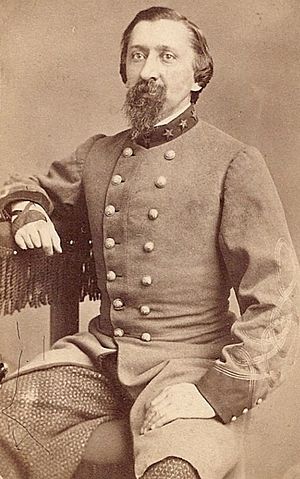Augustus Forsberg facts for kids
Quick facts for kids
Augustus Forsberg
|
|
|---|---|

Colonel Forsberg as wounded in Lynchburg, Virginia.
|
|
| Birth name | Ludwig August Forsberg |
| Born | January 13, 1832 Stockholm, Sweden |
| Died | July 15, 1910 (aged 78) Lynchburg, Virginia |
| Allegiance | |
| Service/ |
Royal Swedish Engineers |
| Years of service | Ca 1850-1855 (Sweden) 1861–1865 (CSA) |
| Rank | |
| Commands held | Forsberg's Brigade |
| Battles/wars | American Civil War |
| Awards | Cited for bravery at Fort Donelson |
| Spouse(s) | Mary Elizabeth Forsberg |
Augustus Forsberg (1832-1910) was a Swedish military engineer. He moved to the United States in 1855. He first lived in Charleston, South Carolina.
When the American Civil War began, he joined the Confederate army. He became a lieutenant in 1861. He was part of the 51st Virginia Infantry regiment. Later, he became its colonel. By the end of the war, he commanded a group of soldiers called a brigade. He was hurt in battle at Winchester in 1864. He became a prisoner of war at Waynesboro in 1865. After the war, he settled in Lynchburg, Virginia. He married a woman he had met there. Forsberg worked as the city engineer for over twenty years.
Contents
Early Life and Moving to America
Augustus Forsberg was born in Stockholm, Sweden. He studied at the KTH Royal Institute of Technology. This is a famous engineering school. After graduating, he became a lieutenant in the Swedish Engineer Troops. These were soldiers who built things like bridges and forts.
In 1855, Forsberg moved to the United States. He worked as an engineer in Charleston, South Carolina. He helped with a government building project there. Later, he worked as an architect in Baltimore. He also worked as a draftsman (someone who draws plans) for the United States Capitol Building in Washington, D.C. This building was still being built at the time.
Joining the Civil War
Here lies this generous stranger, who watered with his precious blood the tree of liberty.
A tribute spoken at Forsberg's funeral.
Augustus Forsberg strongly supported the Southern states. When the Civil War started, he was warned that the U.S. government might arrest him. He quickly found a fishing vessel to take him to Charleston. There, he volunteered as a topographical engineer. This meant he helped map the land for the city's defense.
In August 1861, Forsberg moved to Richmond, Virginia. He met John B. Floyd, a former U.S. Secretary of War. Floyd told him to ask Jefferson Davis, the Confederate President, for a military job. Forsberg was made a lieutenant. He was sent to work with General Floyd in the Kanawha Valley.
Forsberg became a first lieutenant in the regular Confederate States Army. This was the main army of the Confederacy. His new rank was confirmed in January 1862. In August 1861, he was sent to help train the soldiers of the 51st Virginia Infantry. He stayed with this group for the rest of the war.
In February 1862, his regiment went to Fort Donelson. They were sent to help defend the fort. Lieutenant Forsberg was praised for his bravery during the Battle of Fort Donelson. When the fort had to surrender, Forsberg's group managed to escape.
Leading in Battle
After escaping, the 51st Virginia Infantry returned to Virginia. The regiment was reorganized at Wytheville. Many officers left, and new ones were chosen. Forsberg was elected as the new lieutenant colonel in May 1862.
In August 1862, Colonel Gabriel C. Wharton became a brigade commander. A brigade is a large group of soldiers. Lieutenant Colonel Forsberg took his place and began leading the regiment. In July 1863, Forsberg was promoted to full colonel.
He was in a hospital in Lynchburg, Virginia during the Battle of New Market. So, he could not lead his regiment in that important fight. During the Battle of Lynchburg, Forsberg commanded Wharton's brigade. He led the brigade again at the Third Battle of Winchester. There, he was shot in his right hand while trying to encourage his men.
He did not return to duty until February 1865. He then took command of the brigade again. At the Battle of Waynesboro, Forsberg and most of his soldiers were captured. They became prisoners of war.
Life After the War
Forsberg was held as a prisoner of war at Fort Delaware. He was released in June 1865. He then went back to Lynchburg, Virginia. He had been there before, recovering from his injury at Winchester.
While recovering, he met Mary Elizabeth Otey. She was a widow whose husband had died early in the war. Mary Elizabeth worked as a nurse at the Ladies Relief Hospital. Her mother-in-law, Lucy Mina Otey, had started the hospital.
Soon after his release, Forsberg married Mary Elizabeth. They started a family and lived in Lynchburg. Forsberg worked as the city engineer for 21 years. He designed many public buildings in the city. Some of his designs are in the Fifth Street Historic District.

